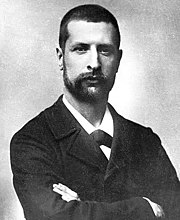Alexandre Yersin's Human Design Chart
1/4 Splenic Projector**Alexandre Yersin** (September 22, 1863 – March 1, 1943) was a Swiss and French physician and bacteriologist celebrated for his groundbreaking contributions to medical science, particularly as the co-discoverer of the bacillus responsible for the bubonic plague, later named *Yersinia pestis* in his honor. Born in Aubonne, Switzerland, Yersin’s remarkable journey in medicine was deeply influenced by his Human Design profile as a Projector with Splenic Inner Authority.
Yersin’s educational path began with the study of medicine at Lausanne, Switzerland, from 1883 to 1884, followed by further studies in Marburg, Germany, and Paris until 1886. As a Projector, he thrived in environments where he could receive invitations to share his insights, a trait that became evident when he joined Louis Pasteur’s research laboratory at the École Normale Supérieure. Here, he played a pivotal role in developing the anti-rabies serum, demonstrating his ability to respond to the needs of the scientific community.
In 1888, Yersin earned his doctorate with a dissertation titled *Étude sur le Développement du Tubercule Expérimental* and spent two months with Robert Koch in Germany. His collaboration with Émile Roux at the Pasteur Institute led to the discovery of the diphtheric toxin, further establishing his reputation as a leading figure in bacteriology. Yersin’s success was often linked to his Projector nature, which allowed him to wait for the right invitations to act, enabling him to make significant contributions to the field.
In 1890, Yersin ventured to French Indochina as a physician for the Messageries Maritimes company, where his explorative spirit resonated with his 1/4 Profile, characterized by a deep desire for knowledge and a strong foundation in research. His pivotal moment came in 1894 when he was sent to Hong Kong to investigate the Manchurian Pneumonic Plague epidemic. In a small hut next to the institute, he made his most significant discovery: identifying the pathogen that causes the disease. Despite competition from Dr. Kitasato Shibasaburō, Yersin’s unique laboratory conditions allowed him to excel in this critical moment, showcasing the importance of his Splenic Authority in making timely, instinctual decisions.
Yersin continued to pursue studies on the bubonic plague, preparing the first anti-plague serum with his colleagues and establishing a laboratory in Nha Trang, which later became a branch of the Pasteur Institute. His work in agriculture, particularly in cultivating rubber trees and acclimatizing the quinine tree, reflected his innovative spirit and desire to contribute to the local economy and health.
In Vietnam, Yersin was affectionately known as Ông Năm (Mr. Nam/Fifth) and is celebrated for his humanitarian efforts. His legacy endures through various institutions named in his honor, including the Yersin Museum in Nha Trang and Yersin University in DaLat. His tomb, adorned with a pagoda, serves as a site of veneration, acknowledging him as a benefactor and humanist revered by the Vietnamese people.
Yersin’s life and work exemplify the qualities of a Projector, whose strategy of waiting for invitations allowed him to make profound contributions to science and medicine. His Incarnation Cross, the Right Angle Cross of The Vessel of Love, reflects his deep connection to humanity and the love he shared through his life’s work. With channels 57-10 and 7-31, Yersin embodied the intuitive and strategic qualities of a Projector, guiding him in his impactful career. He passed away in Nha Trang during World War II, leaving behind a legacy that continues to inspire future generations.
Discover More Famous People
Browse and analyze over 55,000 public figures and celebrities.
Ra Uru Hu
5/1 Manifestor
Martha Stewart
4/6 Manifestor
David Lynch
4/6 Generator
Barack Obama
6/2 Projector
Steve Jobs
6/3 Generator
Vladimir Putin
5/1 Manifestor
Kim Kardashian
3/5 Generator
Michael Jackson
1/3 Projector
Marilyn Monroe
6/2 Projector
Ariana Grande
2/4 Projector
Oprah Winfrey
2/4 Generator
Johnny Depp
2/4 ManifestorWhat is HumanDesign.ai and how does it work?
Curious what makes Alexandre Yersin tick? HumanDesign.ai instantly maps their exact birth data into a fully interactive clickable bodygraph chart, letting you hover or tap every center, channel, and gate for plain-language explanations. Bella, the platform’s built-in AI guide, adds context in real time, translating complex mechanics into everyday insights so you can see how Alexandre Yersin’s strengths, challenges, and life themes play out on-screen.
The same tools are waiting for you. Generate your own Human Design Chart in seconds, open a library of 2000+ suggested questions, and chat with Bella as often as you like to decode your design, daily transits, and even relationship dynamics.
Want to compare energies? Save unlimited charts for friends, family, or clients, then ask Bella to reveal compatibilities, composite patterns, or coaching tips, all in one conversation thread.
Start free with core features, or unlock our Personal and Pro plans for deeper dives: unlimited Q&A, celebrity chart search spanning 55,000+ public figures, white-label PDF reports, branded content generation, and a professional profile with built-in booking for practitioners. Whether you’re exploring your own potential or guiding others, HumanDesign.ai delivers an ever-expanding toolbox of AI-powered insights—no spreadsheets, no jargon, just clarity at your fingertips.
Ready to see yours? Signup for FREE today!

